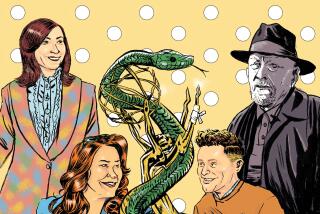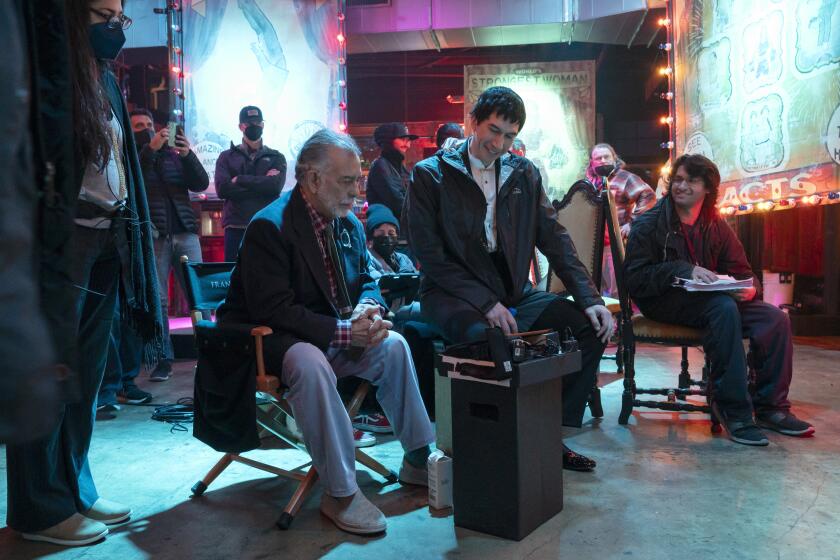Reading the Signs in Competition for a Costume Oscar
There’s more to winning an Oscar for costume design than just making the prettiest clothes. And in tracing the steps that led Jenny Beavan and John Bright of “Room With a View” to this year’s prize, it appears they had a leading edge from the start.
While there is no foolproof formula for predicting who will walk away with the award, longtime members of the Motion Picture Academy’s costume-design division, who nominate the best costume award winners, say they have learned to read the signs.
And long before this year’s votes were cast, the strongest indicators pointed to Beavan and Bright. First, because “Room With a View,” based on the novel by E. M. Forster, is set in 1908.
“Period pieces tend to be nominated most often, because of all the research and workmanship involved,” says Carol Strausser, who heads Hollywood’s costume-design guild.
(All the costume-design nominees this year were historical films, with the exception of “Peggy Sue Got Married,” which flashed back to the 1950s. The other nominees were “The Mission,” “Otello” and “Pirates.”)
Beavan and Bright can also thank their home base, London, for giving them a leg up in this year’s competition. The city’s repository of historic costumes for stage and screen is arguably the best in the world. And the fact that Bright owns Cos-prop, one of the three major costume-supply houses in town, certainly didn’t hurt. All of the clothes in the film came from his stock, with which he is thoroughly familiar.
“John has been collecting costumes for more than 20 years,” Beavan says of her partner. His company supplies props as well as costumes for stage, film and television productions. He recently helped outfit the British Broadcasting Co. TV production “Lost Empires” and earlier supplied garments for the film “Out Of Africa,” an Oscar nominee for costumes last year.
Beavan and Bright first teamed up when she went to select costumes from Cos-prop for “The Bostonians,” a Merchant Ivory production, as was “Room With a View.” She had only two weeks to outfit the film; he became very involved in the project, and they shared the wardrobe credit.
Some of the costumes they collaborated on for “Room With a View” were refurbished originals, refitted to the actors’ figures. Other outfits were made-from-scratch copies of clothes in Bright’s collection, Beavan explains. There were no clothes she styled on her own. “I’m not the least bit interested in designing,” she says. “My talent is more in knowing how to fit and cinch older clothes. The corset underneath is what really makes it.”
The right corset did as much as anything to win Beavan her award, the chairman of the Costume Design Rules Committee for the Oscars, Elois Jenssen, says.
“The Americans are lazy,” Jenssen finds. “Our actors say they’re not comfortable wearing the proper corsets in a period film, so we don’t force them. And it makes a difference in the look.”
She also believes Hollywood costumers and designers are not usually well trained, and that puts them at a disadvantage.
Beavan’s credentials, however, include a degree in theater arts, an apprenticeship with Merchant Ivory, assignments for British television and the Royal Opera. Another key to Beavan and Bright’s success is their history of working well together, Jenssen believes.
Finally, Jenssen believes the film’s overall continuity enhanced the British team’s work, which helped put them in the winner’s circle. Hair styles and makeup were in tune with the costumes. But beyond that, she says, “everything about the picture, from the music to the titles, looked as if it was cut of the same cloth.”
The film did particularly well at the box office. When it came time for Academy members to vote, its broad exposure and popular appeal made a difference, Jenssen says.
“I imagine John and I will get other offers for work, and I wouldn’t turn anything down just because it came from Hollywood,” Beavan says. “But winning the award doesn’t mean for me what it means to costume designers here. No way do I want to get involved in big Hollywood pictures. I like the control of a small film.”
Even before the Oscar ball ended on this year’s awards night, more than one Hollywood producer told Beavan she was wrong to expect offers for other work.
“They said they can’t afford me anymore. There’s an assumption here that you’re out of the price range after you’ve won an Oscar.”
She says she doesn’t plan to raise her prices. But Albert Wolsky, who won an Oscar in 1979 for “All That Jazz” and designed the costumes for this year’s two-time Oscar nominee film, “Crimes of the Heart,” admits he doubled his prices once he had his award.
Beavan says she and Bright start work on “The Deceivers” in September. It is a Merchant Ivory-produced period piece based on the John Masters novel set in India, 1825. Whether or not it wins her an Oscar, it has already won her affection.
“I’m only interested in clothes that tell a story,” she says.
More to Read
Only good movies
Get the Indie Focus newsletter, Mark Olsen's weekly guide to the world of cinema.
You may occasionally receive promotional content from the Los Angeles Times.










